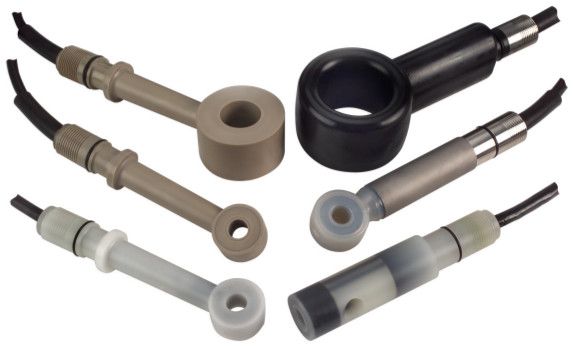SE 871EC Electrodeless Conductivity Sensors
Electrodeless Conductivity Sensors and Accessories 871EC

The electrodeless conductivity sensors measure an induced current in a loop of solution. Two or three(1) toroidally wound coils are encapsulated in close proximity within the sensor which is immersed in the solution. An ac signal, applied to one toroidal coil, induces a current in the second coil, which is directly proportional to the conductance of the solution. This current is the input to a Foxboro Model 875EC Intelligent Analyzer, a Model 870ITEC Intelligent Transmitter, a Model 870EC Analog Transmitter, or Models 873EC and 873AEC Electrochemical Analyzer, all used for electrodeless conductivity measurement.
HIGH SENSITIVITY
Through the use of innovative design technology(1), Foxboro has extended the range of electrodeless conductivity measurement capability. Whereas previous sensors were limited to ranges of 1000 μS/cm minimum full scale, the Foxboro large bore PEEK sensors can be ranged as low as 0 to 50 μS/cm, with sensitivities as low as approximately 8 μS/cm. This permits measurements in low conductivity applications such as boiler feedwater or steam condensate, where heretofore the electrodeless technique was not sufficiently sensitive.
PEEK MATERIAL SOLVES APPLICATION PROBLEMS
PEEK (Polyetheretherketone) is a thermoplastic material with superb strength and chemical resistance properties over a wide range of process temperatures and pressures. PEEK sensors are available in both small and large bore configurations; each type is capable of measuring conductivity at temperatures up to 200°C (392°F).
WIDE APPLICATION FLEXIBILITY
The Model 871EC Electrodeless Conductivity Sensors are available in a number of configurations and materials suitable for a variety of conditions that may be present in highly corrosive process solutions. These process conditions may include fouling by oil, algae or suspended impurities, abrasive slurry erosion, or metallic corrosion in highly active chemical solutions (e.g., caustics, saline solutions, and acids). Refer to Table 2 for approximate conductivity values of many common solutions.
VERY RELIABLE DESIGN
Foxboro PEEK sensors utilize a proprietary sensor head sealing technique which obviates the need for physical seals such as O-rings or epoxies. This results in a sensor of extraordinary integrity and virtually impervious to leakage from process fluids.
EASY MAINTENANCE
All sensors incorporate short passages and sufficiently large bores to virtually eliminate the difficulties caused by the buildup of process material and electrode polarization that is experienced with direct contact electrodes. Because of the materials of construction and innovative design, sensor maintenance is typically negligible.
VERSATILE SENSOR MOUNTINGS
Modular sensor design offers a choice of several different mounting methods. In-line installations are achieved via threaded bushings, flanges, and ball valve assemblies. A process seal is achieved by the sensor O-ring sealing against the bushing or flange inside diameter. All sensors may also be submersed by using a standpipe and coupling. Refer to Sensor Mounting Arrangements section further in this document for typical sensor mountings.
INTEGRAL TEMPERATURE SENSING
Sensors have an integral temperature element (either a thermistor or an RTD) for the monitoring of process solution temperature. Encapsulating the thermistor or RTD (resistance temperature detector) ensures that it is located in intimate thermal contact with the process solution being monitored, thereby providing an accurate response.
If you require further information on this product or would like a quotation, please contact dp-flow on:
email: sales@dp-flow.co.uk
sales +44(0)1608 544222
Supplied by DP-Flow